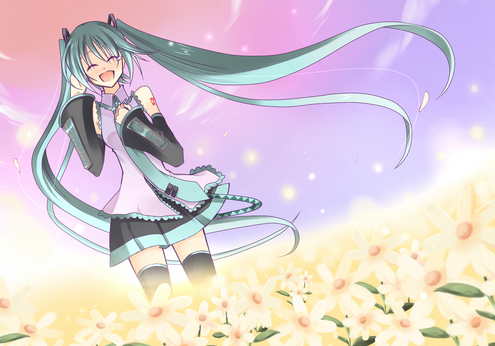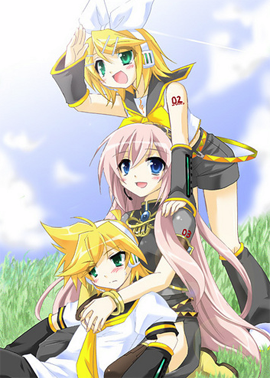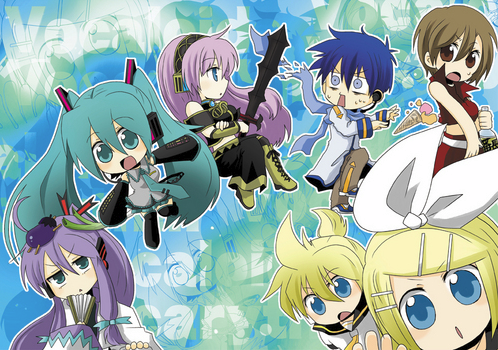PRIMER: An introduction to Vocaloid
Sourced from darknightrain's LJ, this is somewhat old and somewhat generalised, but works well as an introduction to singing robots and the fandom we inhabit.
We would be extremely grateful for comments, additions, rewrites or suggestions as towards making these primers better. All the primer posts will get linked in the profile and sidebarred, and it's our hope we can keep people's attention on them and updating so that we retain an up-to-date resource of information.
Vocaloids can be broadly described as little anthropomorphised voice synthesizer robots which - coming from Japan and all - are primarily moe and small and belt out whatever speech patterns you program into them for your delectation. What was slightly unexpected was the sheer viral level of popularity they gained and the number of budding songwriters around that just needed someone to sing for them to suddenly be able to produce a selection of astonishingly good music tracks.

Vocaloid is a "technology" developed by Yamaha. Believe it or not, the very first Vocaloids created were programmed using English-speaking singers, but it wasn't until the Japanese company Crypton thought of giving the voice banks a graphic representation that the software really became popular. The two very first Vocaloids to become mascot charas were MEIKO and KAITO (pictured above). Since they work off the early Vocaloid engine, their voices aren't as smooth or natural sounding as everyone else's, but they're the ones with the widest genre range. (And they can sound real nice, if the producer knows what they're doing.)

In January 2007 the Vocaloid2 engine was released and with it, the infamous Hatsune Miku. From her adorably moe character design and voice to the fact that her "forte" are J-pop songs, Miku had everything she needed to become a world famous idol. Many people would have her cover anything from well-known anime OP-EDs to infectious internet memes to original songs. Producers made use of Nicovideo (the Japanese Youtube) to put their songs out there for the world to listen to and it all started snowballing downhill. People would create animate video clips for the song, cover them using other Vocaloids (or their own voices), and begin giving the adorable singing robots all sorts of different personalities.

Because, you see, aside from a couple official stats (birthday, height, etc), Vocaloids have no real personality or backstory, and this is exactly what their charm consists of. They are... visual templates for original characters. Do you want Miku to be an adorable blushy schoolgirl? Or maybe a tsuntsun office lady? Or perhaps a wold famous pop idol who is obsessed with her manager and will eventually end up murdering him in a horrible way? Thanks to the magic of Vocaloid, you can. And while you'd think this could be terribly dangerous and counterproductive in an internets full of sparkly Mary Sue Self Inserts, you would be mistaken. The producers who work with Vocaloid tend to be not only amazingly musically talented, but also really good writers. And so you can have heart wrenching sagas that span across 2 or more songs, or fucking creepy stories that will give you nightmares, or... others that will just make you lol a lot. When we say there is a Vocaloid song/characterization for everyone out there, we do not lie.
More Vocaloids followed after Miku, and Internet (another company) even got artists like Gackt and Nakajima Megumi (aka Ranka Lee) to lend their voices for Vocaloids. More English Vocaloids have come out as well, but they haven't been as popular as their Japanese counterparts... I guess because us Westerners aren't as crazy as those Japanese with their moe moe singing robots. Still, they get used fairly often and provide their own share of amusement.

Digging a little deeper, you are likely to find amazing covers done by really talented singers and musicians. It is no secret that thanks to this fandom, many of them have gotten labels to look at them and are now professional artists getting paid for their music. And this is all not counting the artists who draw/animate for the songs and who are just equally good; Miwa Shirow, for example, is a big Vocaloid fan and he is part of Supercell, one of the most popular groups that has worked with Vocaloid (who you may recognize because they did Bakemonogatari's ED theme along with Nagi/Gazelle... yes, a Nicosinger).
There's also genderswitches, fanmade Vocaloids (some of them have gotten official recognition from Crypton), metal!Vocaloids, and a dozen other subfandoms that I won't even touch on because then this post would get even longer. But... again, Vocaloid is a fandom that has something awesome to offer to everyone.

The reason we like this fandom and community so much is this wonderful granularity - the ability to find or do pretty much whatever you want, the capacity for producers and artists and singers either to span across massive epics or otherwise laugh at each other and send each other up without a trace of seriousness, and a fandom that can stretch in scope from professional and gigantic to tiny and genially casual.
ALLOW US TO DEMONSTRATE WITH A FEW EXAMPLES:
AWESOME VIDEOS: Heartbreak Summit, Meltdown, IMITATION BLACK
STUPID/CUTE: Super Turkish March Owata, Vocaloid Ranking Deception, Go Google It
HORROR: Alice Human Sacrifice (fancover), Dark Wood Circus and its sequel/prequel, Circle You Circle You
TEARJERKERS: HEART and its sequel, also The Disappearance of Hatsune Miku
EARWORMS: Just Be Friends, Dancing Samurai, B.P.M.
AMAZING COVERS: World Is Mine (original), Romeo And Cinderella (original), Iroha Uta (original)
(Last Updated: Feb 4th, 2010)
We would be extremely grateful for comments, additions, rewrites or suggestions as towards making these primers better. All the primer posts will get linked in the profile and sidebarred, and it's our hope we can keep people's attention on them and updating so that we retain an up-to-date resource of information.
Vocaloids can be broadly described as little anthropomorphised voice synthesizer robots which - coming from Japan and all - are primarily moe and small and belt out whatever speech patterns you program into them for your delectation. What was slightly unexpected was the sheer viral level of popularity they gained and the number of budding songwriters around that just needed someone to sing for them to suddenly be able to produce a selection of astonishingly good music tracks.

Vocaloid is a "technology" developed by Yamaha. Believe it or not, the very first Vocaloids created were programmed using English-speaking singers, but it wasn't until the Japanese company Crypton thought of giving the voice banks a graphic representation that the software really became popular. The two very first Vocaloids to become mascot charas were MEIKO and KAITO (pictured above). Since they work off the early Vocaloid engine, their voices aren't as smooth or natural sounding as everyone else's, but they're the ones with the widest genre range. (And they can sound real nice, if the producer knows what they're doing.)

In January 2007 the Vocaloid2 engine was released and with it, the infamous Hatsune Miku. From her adorably moe character design and voice to the fact that her "forte" are J-pop songs, Miku had everything she needed to become a world famous idol. Many people would have her cover anything from well-known anime OP-EDs to infectious internet memes to original songs. Producers made use of Nicovideo (the Japanese Youtube) to put their songs out there for the world to listen to and it all started snowballing downhill. People would create animate video clips for the song, cover them using other Vocaloids (or their own voices), and begin giving the adorable singing robots all sorts of different personalities.

Because, you see, aside from a couple official stats (birthday, height, etc), Vocaloids have no real personality or backstory, and this is exactly what their charm consists of. They are... visual templates for original characters. Do you want Miku to be an adorable blushy schoolgirl? Or maybe a tsuntsun office lady? Or perhaps a wold famous pop idol who is obsessed with her manager and will eventually end up murdering him in a horrible way? Thanks to the magic of Vocaloid, you can. And while you'd think this could be terribly dangerous and counterproductive in an internets full of sparkly Mary Sue Self Inserts, you would be mistaken. The producers who work with Vocaloid tend to be not only amazingly musically talented, but also really good writers. And so you can have heart wrenching sagas that span across 2 or more songs, or fucking creepy stories that will give you nightmares, or... others that will just make you lol a lot. When we say there is a Vocaloid song/characterization for everyone out there, we do not lie.
More Vocaloids followed after Miku, and Internet (another company) even got artists like Gackt and Nakajima Megumi (aka Ranka Lee) to lend their voices for Vocaloids. More English Vocaloids have come out as well, but they haven't been as popular as their Japanese counterparts... I guess because us Westerners aren't as crazy as those Japanese with their moe moe singing robots. Still, they get used fairly often and provide their own share of amusement.

Digging a little deeper, you are likely to find amazing covers done by really talented singers and musicians. It is no secret that thanks to this fandom, many of them have gotten labels to look at them and are now professional artists getting paid for their music. And this is all not counting the artists who draw/animate for the songs and who are just equally good; Miwa Shirow, for example, is a big Vocaloid fan and he is part of Supercell, one of the most popular groups that has worked with Vocaloid (who you may recognize because they did Bakemonogatari's ED theme along with Nagi/Gazelle... yes, a Nicosinger).
There's also genderswitches, fanmade Vocaloids (some of them have gotten official recognition from Crypton), metal!Vocaloids, and a dozen other subfandoms that I won't even touch on because then this post would get even longer. But... again, Vocaloid is a fandom that has something awesome to offer to everyone.

The reason we like this fandom and community so much is this wonderful granularity - the ability to find or do pretty much whatever you want, the capacity for producers and artists and singers either to span across massive epics or otherwise laugh at each other and send each other up without a trace of seriousness, and a fandom that can stretch in scope from professional and gigantic to tiny and genially casual.
ALLOW US TO DEMONSTRATE WITH A FEW EXAMPLES:
AWESOME VIDEOS: Heartbreak Summit, Meltdown, IMITATION BLACK
STUPID/CUTE: Super Turkish March Owata, Vocaloid Ranking Deception, Go Google It
HORROR: Alice Human Sacrifice (fancover), Dark Wood Circus and its sequel/prequel, Circle You Circle You
TEARJERKERS: HEART and its sequel, also The Disappearance of Hatsune Miku
EARWORMS: Just Be Friends, Dancing Samurai, B.P.M.
AMAZING COVERS: World Is Mine (original), Romeo And Cinderella (original), Iroha Uta (original)
(Last Updated: Feb 4th, 2010)